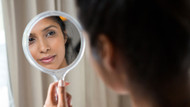Posted by Kris Allo on Jul 25th 2025
The Scar That Wasn’t There: The Art of Perception
We often think we’re seeing reality. But more often, we’re seeing our expectations, our conditioning, or our past.
In a 1980 study at Dartmouth University, researchers invited participants to take part in what they were told was an experiment on how people respond to facial disfigurement.
Each student volunteer had a realistic-looking scar painted onto their cheek using theatrical makeup. They were supposed to go out into the world with their new scar, observe how strangers treated them, and report back to the researchers. After looking at themselves in the mirror and being reminded of the purpose of the experiment, they prepared to set out.
But just before they left, a makeup artist returned and said one final touch-up was needed. What the participants didn’t know was that in this final step, the makeup artist actually completely removed the scar.
When they returned from their interactions, their reports were striking. They described their interaction partners as more tense, less at ease, and in some cases, subtly patronizing. Many focused on how the other person had looked at them—things like avoiding eye contact, glancing too much, or seeming distracted.
Yet, there had been no scar.
Nothing about their appearance had actually changed. What changed was the belief they carried with them.
What the study points to is profound: We don’t experience the world as it is. We experience it as we believe it to be.
The mind doesn’t show us “reality.” It shows us what it expects—based on past experiences, memories, cultural conditioning, and identities. Our perception of everything is shaped from the inside out.
Energy Meets Perception
Here at Change Your Energy, we talk about the energy of art and how intention, and vibration get infused into each stroke or form. But something else to remember is this:
The viewer brings their own energy, too.
The way you experience a painting is shaped not just by what the artist placed into it, but by what you bring to it: your mood, your state of nervous system regulation, your memories and subconscious expectations, your emotions, your openness, your closedness, and so on.
If you’re feeling constricted or unsettled, you might see tension or mess in the piece. If you’re grounded and calm, you might sense flow or beauty in the exact same brushstrokes.
So standing in front of a painting is more of a dialogue than a monologue. It’s a conversation between energies.
The energy of the art + the energy of the viewer = the experience.
Just like the scar study, what we carry inside shapes what we see, often without us realizing it.
Practicing Expanded Perception
Perception isn’t fixed. It can change once we become aware. Here are some ways to open yourself up to new perception through looking at art.
- Try describing what you see in purely objective terms:
“There’s a red line that goes about one-third down the page.”
“There are long, curved shapes coming out of a square.”
“There’s a pale blue area in the top right corner.”
That’s it. No story. No analysis. No emotional meaning. Just observation.
This gives the thinking mind something to do so it doesn’t rush ahead to interpret. It creates space between the stimulus and a story.
- From there, try asking:
- What else could this be?
- How many other ways are there to see this?
- How might a child see this? Or an animal, or a tree?
- How might someone I admire—someone who sees clearly and compassionately—view this piece?
- How would I see it if I were completely free of my usual story?
These aren't questions meant to provoke overthinking. They’re reminders that there are always other ways to see. Approach them with lightness and curiosity.
In that space of curiosity and non-attachment, something interesting might happen. You might begin to notice that you’re not just looking at art—you’re looking at your own reflection. And when the surface quiets, what’s true begins to shine through.
Zero Point: Seeing from the Space before Thought
We call this kind of perceptual space zero point. It’s a place free from duality and judgment, and beyond story and meaning. It’s where the mind has given up its chatter and become quiet, so something more essential can emerge.
Zero point is your original nature. It’s the part of you that existed before beliefs were formed. Before the mind filled in the gaps with its expectations.
When we practice seeing from this space, we begin to see with our inner eyes more than our outer ones. We begin experiencing the energy of life from our deeper, truer self.
Letting Go of the Scars
We don’t only project old pain onto ourselves or the people around us; we project it onto the entire world.
Often, what we end up seeing isn’t just what is. It’s a projection of our personal and collective trauma… shaped by what we’ve known, what we’ve feared, and what we focus on.
This doesn’t mean the world isn’t struggling. There is real pain here.
But the lens we look through shapes how much of that we carry in our bodies each day, and how much space we have left for anything else.
When we remember that perception is not a fixed truth, but a habit… we begin to reclaim our agency. We can practice seeing not just with fear or fatigue, but with intention and courage. With a deeper kind of trust.
That choice doesn’t erase the world’s pain, but it helps us meet it with clearer vision and steadier presence.
What would it be like if we saw through the eyes of our original nature more often? If we let go of the scars that only exist in our minds?
If we can soften the grip of our projections, we can return to a space of presence, truth, and clarity.
From there, life becomes better. Not because the world changed, but because we did.
Check out the energy art and products in our shop to expand your perception and connect to something true.

